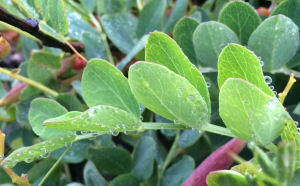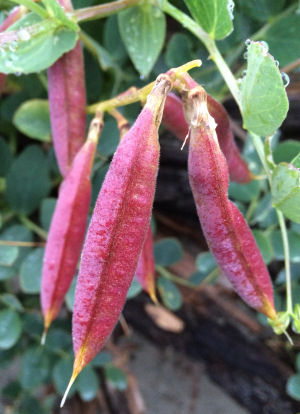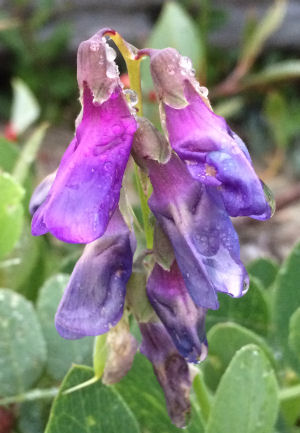Beach Pea - Lathyrus japonicus
- Family: Fabaceae [E-flora]
SUBTAXA PRESENT IN BC
- Lathyrus japonicus var. maritimus [E-flora]
Introduction
"Beach pea is a perennial, rhizomatous herbaceous species that is circumboreal in distribution. It is "widely distributed on coasts of temperate Asia, Europe, North America, and South America (Chile)" (Flora of China 2011)." [E-flora]
"In North America, this includes the coastal areas of the Great Lakes. In British Columbia, it ranges along the Pacific coast from Vancouver to just north of Prince Rupert. This low growing, blue/pink/purple flowering species trails or climbs in well-drained sandy habitats proximal to the ocean (sandy coastal areas/foredunes/foredune grasslands), in dynamic drift areas or on stabilized foredunes. Leaves are alternate and pinnately compound with 6-10 leaflets, stems are not winged, and pods are hairy. Flowers are often two-coloured and are in racemes of 2-7." [E-flora]
"Lathyrus japonicus maritimus is a PERENNIAL growing to 0.6 m (2ft).
It is hardy to zone (UK) 3. It is in flower from May to August, and the seeds ripen from Aug to October. The flowers are hermaphrodite (have both male and female organs) and are pollinated by Bees, lepidoptera.It can fix Nitrogen.
Suitable for: light (sandy), medium (loamy) and heavy (clay) soils and prefers well-drained soil. Suitable pH: acid, neutral and basic (alkaline) soils. It cannot grow in the shade. It prefers dry or moist soil. The plant can tolerate maritime exposure." [PFAF]
- Synonyms
- Origin Status: Native [E-flora]
- General: Perennial herb from a rhizome; stems trailing to climbing, 10-150 cm long, angled or flanged but not winged, glabrous to short-hairy. [IFBC-E-flora]
- Leaves: Alternate, pinnately compound with 6 to 12 leaflets; leaflets paired or scattered, egg-shaped to oblong, 1-7 cm long, 0.5-4 cm wide, rather fleshy, strongly veined when dry; tendrils well developed, grasping or branched or neither; stipules large, leafy, obliquely arrowhead-shaped, about as long as the leaflets. [IFBC-E-flora]
- Flowers: Inflorescence a loose, stalked, axillary cluster of 2 to 8 pea-like flowers; corollas reddish-purple to blue, often 2-coloured, up to 3 cm long, the wings and keel shorter than the banner, the banner-claw equal to the blade; calyces 10-15 mm long, the teeth lanceolate, the upper pair 1/2 as long as the lateral pair which are 1-2 mm shorter than the lowest one, all three of the lower teeth longer than the tube. [IFBC-E-flora]
- USDA Flower Colour: Purple, Blooming Period: Early Spring [USDA-E-flora]
- Fruits: Pods, usually hairy, 3-7 cm long, 1 cm wide; seeds 5 to16. [IFBC-E-flora]
- USDA Fruit/Seed characteristics: Black. Present from Spring to Summer [USDA-E-flora]
- Habitat & Range: "Sandy or gravelly beaches (often amongst driftwood), dunes, rocky headlands in the lowland zone; common in coastal BC; circumboreal, N to AK, E to NF and S to N CA; Eurasia, Chile." [IFBC-E-flora] "Shingle beaches and sand dunes[17, 187]. Circumpolar, south to Britain, France, Mongolia." [PFAF] "Circumboreal, south in eastern North America to NJ (or NC?) and the shores of the Great Lakes. Reported from ocean beaches in Dare County (NC)..." [Weakley FSMAS]
Hazards
- Lathyrism: "The seed contains a toxic amino-acid which, in large quantities, can cause a very serious disease of the nervous system known as 'lathyrism'. [65, 76]. The seed is said to be perfectly safe and very nutritious in small quantities, but should not comprise more than 30% of the diet[65, 76]." [PFAF]
- “Eaten in moderation, peavines can provide a nutritious food, but if the diet consists almost exclusively of peavine for 10 days to 4 weeks, a type of cumulative poisoning called “lathyrism” can result as human proteins are denatured by incorporating the unusual amino acids. Even the common garden pea (Pisum spp.) can cause nervous disorders if large amounts are eaten regularly over long periods of time. Lathyrism causes a progressive loss of coordination, which in extreme cases can end in irreversible paralysis.” [EMPofCan]
- "...Even common garden peas, says Donald Kirk in Wild Edible Plants of Western North America, ". . . can cause nervous disorders if eaten in great quantities over long periods of time." Eat both wild and domestic peas in moderation only." [Schofield]
- "Beach Pea is often considered poisonous, and it does contain some toxins, but the amount you would ingest from eating the seeds or pods is negligible and cooking removes a lot of the toxin. The toxin, B - aminopropionitrile (BAPN) is unusual in that it inhibits the cross linkage of protein and can cause irreversible paralysis. Fortunately this only occurs if the plant is eaten in quantity, as almost the only food, for long periods. Ironically this destructive substance is being studied for its potential to extend life, by reversing the aging process." [Tozer UWP]
Food Use
- Peas: In late summer, shelled peas were gathered. Nutritionally, the shelled peas of beach pea are high in both protein and vitamins A and B. The Dena'ina ate beach pea seeds raw or boiled and preserved in seal oil. [EMPofCan] "These are quite palatable if gathered while young, but many people make the mistake of gathering them when they are old and tough... The immature pods, or peas, can be boiled, stir-fried or steamed. The mature peas can be used like dried peas in soups, or ground to flour." [Tozer UWP]
- Nutritional: green peas 68g water and 0.19mg Riboflavin per 100g fresh weight. [Turner,Kuhnlein]
- Coffee: "The roasted seed is a coffee substitute. [61; 183; 257]" [PFAF] "The Inuits dried peas and roasted them like coffee, then percolated." [Meuninck EWPUH]
- Mature Seeds: "Were sprouted and used in salads. [183] Very bitter. [2; 105; 106] [PFAF] Summer. Sweet nibble. Steamed. High in protein, Vitamin A and B. [Schofield]
- Young Seedpods: Raw or cooked when less than 25mm long. [105; 106; 183] Summer. Stir-fried. [Schofield]. In early summer, the tender pods were eaten whole. [EMPofCan] "After peas flower, tender young pods may be cooked and eaten like snow peas." [Meuninck EWPUH] "when young and tender, are a popular cooked edible." [Lincoff TJF]
- Harvesting: "Early summer when the plants are in conspicuous flower". [Lincoff TJF]
- Young plant - "raw or cooked. An excellent sustenance[207]." [PFAF]
- Flowers & Shoots: One of several species "...traded by a small southern-Swedish foraging enterprise, which is also the main provider of wild food plants at the restaurant NOMA, in Copenhagen" [Tardio MWEP]
- Young Shoots: "Raw or cooked. [161] Use young shoots that are less than 25cm long. [172; 213]" [PFAF]. Young shoots in spring when under 10" high. Potherb. Sauteed. [Schofield]. The Iroquois harvested young shoots in spring. [EMPofCan] Native Americans ate the spring foliage when a few inches high. This may contain greater quantities of toxins, so is probably best left alone. [Tozer UWP] Flowers & Shoots collected for consumption. [Luczaj&Pieroni,2016]
Other Use
- Oil: "These were Lathyrus japonicus Willd. (maritime pea) with 4.2% oil and L. venosus Muhl. (veiny pea) with 4.5% oil." [Roth&Carr]
Medicinal Uses
- Nutritional: "Used as a potherb, it is very nourishing to the intestinal tract and toning for the urinary organs." [Schofield] "Chinese use peas as tonic for the urinary organs and intestinal tract." [Meuninck EWPUH]
- Rheumatism: "Coastal Iroquois treated rheumatism with cooked whole young plant." [Meuninck EWPUH]
Phytochemicals
|
L. japonicus
|
|
Flavonoids:
- Delphinidin 5-glucoside 3-rhamnoside (flower) [Bisby]
- Delpinidin 3-glucosylglucoside (flower) [Bisby]
- Malvidin 5-glucoside 3-rhamnoside (flower) [Bisby]
- Myrtillin (flower) [Bisby]
- Petunidin (flower) [Bisby]
- Pisatin (leaf) [Bisby]
|
Aminoacids and peptides
- 3-(benzoylamino)alanine (seed) [Bisby]
- N-y-Glutamyl-L-lathyrine (seed) [Bisby]
- Homoarginine; S-form (seed) [Bisby]
- 5-hydroxy-2-piperidinecarboxylic acid;(2S,5S)-form (seed) [Bisby]
- Lathyrine; (s)-form (seed) [Bisby]
|
Alkaloids
- 5-hydroxy-2-piperidinecarboxylic acid;(2S,5S)-form (seed) [Bisby]
|
|
Lathyrus japonicus subsp. maritimus
|
|
Aminoacids and Peptides
- 2-Amino-4-methylpentanedioic acid (unspecified parts) (Erthro isomer) [Bisby]
- Homoerginine; (S)-form (seed) (Designated B1) [Bisby]
- Lathyrine; (S)-form (seed) [Bisby]
|
Alkaloids
- 4-Chloro-1H-indole-3-acetic acid; Me ester (immature seed) [Bisby]
- 1H-Indole-3-acetic acid; Me ester (immature seed) [Bisby]
|
- "...cis-5-hydroxy-L-pipecolic acid in the seeds of Lathyrus japonicus Willd. [3]." [Hatanaka,1978]
- y-L-glutamyl-L-lathyrine [Hatanaka,1978]
- Toxin: "...Beta-oxalyl- L-alpha-beta diamino propionic acid in seeds of Lathyrus japonicus (Willd.)..." [Lichtfouse SAR 17]
Cultivation:
"An easily grown plant, succeeding in any moderately good garden soil[1]. Prefers a deep moist well-drained soil in a cool position[187]. Prefers a position in full sun, growing well on hot sunny banks[200]. The seed remains viable for 4 - 5 years in sea water[200]. This species has a symbiotic relationship with certain soil bacteria, these bacteria form nodules on the roots and fix atmospheric nitrogen. Some of this nitrogen is utilized by the growing plant but some can also be used by other plants growing nearby[200]." [PFAF]
Aphid Host Plant:
- "Megoura litoralis Müller; Apt. pale green with brownish head and prothorax and appendages, and darker brown SIPH; BL 3.0–4.4 mm. On young growth, flowers and fruits of Lathyrus japonicus ssp. maritimus in NW and N Europe. Mon. hol. with al. males (Heie, 1995)." [Blackman AWHPS]
Propagation
"Pre-soak the seed for 24 hours in warm water and then sow in early spring in a cold frame[200]. When they are large enough to handle, prick the seedlings out into individual pots and plant them out in the summer. If you have sufficient seed, then it can also be sown in situ in mid spring[200]. Division in spring. It may not transplant well so care should be taken[200]." [PFAF]
"Beach Pea is an ecologically and biogeographically interesting species. Plants are reported to flower in their third year, with pollination by long-tongued bumblebees (Low 2005). Seeds of this species disperse in sea water and may remain viable for up to 5 years, which may aid in long-distance dispersal (Wikipedia 2011)."[E-flora]
References
- [Bisby]Phytochemical Dictionary of the Leguminosae, By Frank Bisby, 1994 CRC/Chapman Press
- E-flora - Lathyrus japonicus'', http://linnet.geog.ubc.ca/Atlas/Atlas.aspx?sciname=Lathyrus%20japonicus&redblue=Both&lifeform=7, [Accessed: 12/09/2014]
- [Hatanaka,1978] Hatanaka, Shin-Ichi, and Setsuko Kaneko. "γ-L-Glutamyl-L-Lathyrine from Lathyrus japonicus." Phytochemistry 17.11 (1978): 2027.
- Luczaj&Pieroni,2016 - Łuczaj, Łukasz, and Andrea Pieroni. "Nutritional Ethnobotany in Europe: From Emergency Foods to Healthy Folk Cuisines and Contemporary Foraging Trends." Mediterranean Wild Edible Plants. Springer New York, 2016. 33-56.
- PFAF - Lathyrus japonicus, http://www.pfaf.org/user/Plant.aspx?LatinName=Lathyrus+japonicus+maritimus Plants for a future, Accessed Dec 9, 2014
- Roth&Carr - Roth, W. B., et al. "Evaluation of 107 legumes for renewable sources of energy." Economic botany 38.3 (1984): 358-364.
Page last modified on Sunday, April 12, 2020 6:52 AM




